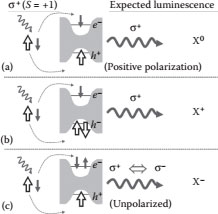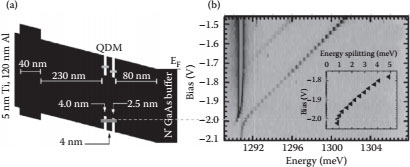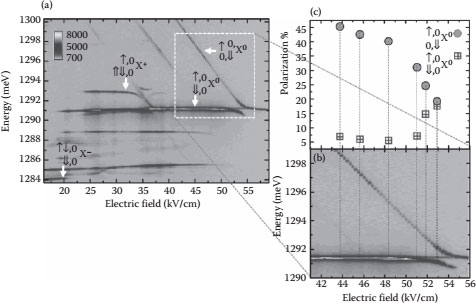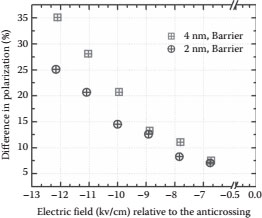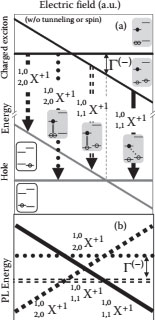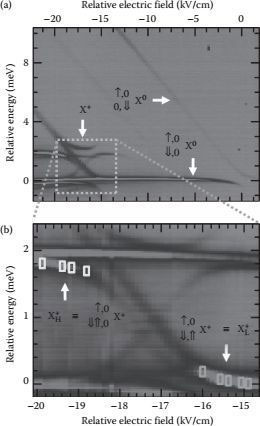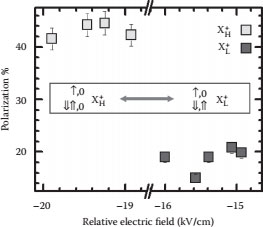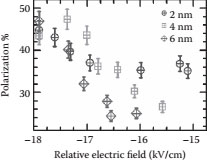Electric Field-Controlled Spin Interactions in Quantum Dot Molecules |
CONTENTS
66.2 Fundamentals in Spin Interactions
66.2.2 Exchange Interaction and Exciton Fine Structure
66.3 Polarization-Resolved Photoluminescence
66.4 Electric Field-Tunable Exchange Interaction
66.5 Spin Effects of Charged Exciton States
Device miniaturization with advanced fabrication techniques has revolutionized the semiconductor industry. This, along with the property of intrinsic carrier spin, may ultimately result in a functional unit utilizing quantum mechanical effects at the fundamental device operating limit. Potential platforms to implement quantum information processing has been demonstrated in many systems, including ion traps [1], nuclear magnetic spin resonances [2], microwave resonators [3], and photonic materials [4]. Among these systems, semiconductor quantum dot molecules (QDMs) are excellent candidates due to 3-D confinement, discrete energy levels, optical access, controllable coupling, and the wealth of semiconductor technology and techniques to draw upon. Spins in these QDMs are considered as a candidate to provide quantum bits (qubits) as they can be initialized, manipulated, and measured through established spectroscopic techniques, for example, via recombination of neutral exciton or charged exciton states (neutral or charged electron–hole pairs). QDMs may also help to realize potential next-generation quantum computing schemes [5] through the generation of entangled photon pairs via neutral biexcitons (exciton pair) [6].
One of the main challenges in implementing quantum information processing is identifying and controlling the spin states that are affected by the fine structure splitting in exciton states [7]. For example, the failure to demonstrate as an ideal source of entangled photons arises due to the inherent electron and hole exchange interaction, related to the structural anisotropy within the QDMs. As biexciton states in QDMs have proven to be useful for demonstrating conditional dynamics, biexciton–exciton cascade paths are useful to identify optical transitions and especially to account for exchange splitting. The anisotropic electron–hole exchange interaction that is typically present in QDMs mixes the pure exciton states, and splits the resulting states, giving distinguishable whichpath information.
The main focus of this chapter is to present some of the effects due to the electron and hole exchange interaction in QDMs and to demonstrate control of the exchange splitting energy. In the devices discussed here, the electron and hole exchange interaction can be varied using an applied electric field. Furthermore, with precise device engineering, one can tune the carrier wave function [8], which may lead to spintronics-based applications. The formation of other charged exciton states can be readily identified through carrier tunneling [9,10] via variations in luminescence intensity. By far, the most attractive feature that differentiates the QDMs from single quantum dots (QDs) is the strong electric field dependence of the indirect exciton states where the electron and hole reside in different QDs within the QDM. Through polarization-dependent photoluminescence (PL) spectra, we could clearly identify the neutral exciton states (direct and indirect configuration) and singly charged exciton states (positive trion) and the spin-dependent interactions in QDMs were investigated. Overall, the electron and hole exchange interaction was controlled either by additional charges that resulted in singly charged states or by spatial variation in the carrier wave function in the InAs/GaAs QDM system.
66.2 FUNDAMENTALS IN SPIN INTERACTIONS
One of the primary experimental techniques mentioned in the introduction is that of optical orientation, which involves the transfer of angular momentum from the light to the crystal. In chargetunable QDs, many efforts have been undertaken to investigate the optical properties of excitonic states through polarization-resolved measurements. Here, we utilize similar techniques to better understand spin effects and probe the carrier spin states in QDMs. In principle, the optical orientation approach demonstrates the angular momentum conservation between light and the crystal nanostructure. With resonant or nonresonant circular polarized laser excitation corresponding to either the right or left circularly polarized light (σ+ or σ−), photons of angular momentum of ±1 (units of ℏ) are attained. When the QDMs are excited with such polarized excitation, it conserves the angular momentum by producing photo-generated electron–hole pairs while conserving the total spin. In the direct band gap semiconductor QDMs, electron states in the conduction band are twofold degenerate with a total angular momentum of J = 1/2. The valence band hole states with the associated p-type Bloch wave character demonstrate a fourfold degeneracy that gives rise to a total angular momentum of J = 3/2 as illustrated in Figure 66.1. The angular momentum projections corresponding to the twofold degenerate heavy holes and the twofold degenerate light holes provide the subbands related to the heavy and light hole states. Furthermore, owing to the compressive strain corresponding to the lattice mismatch between the InAs and GaAs materials and the structural confinement, the light hole subband is shifted in energy and the heavy holes are predominant in the low energy states. Thus, the recombination of excitons comprising electrons and heavy holes, in agreement with optical transition selection rules, gives rise to the circularly polarized light of σ+ or σ− as depicted in Figure 66.1.
FIGURE 66.1 Optical orientation process. Defined spin orientations of the electrons and holes are attained with circular polarized light and identified in agreement with the optical selection rules and device characteristics. Detecting the orientation of the emitted light also reveals the associated spin states of the electron and hole pair.
FIGURE 66.2 Expected luminescence from circularly polarized σ+ excitation corresponding to a (a) neutral exciton, (b) positively charged exciton, and (c) negatively charged exciton with associated spin configurations.
Measuring the luminescence polarization, the spin states of different excitons can be investigated through optical pumping as discussed above. To gain insight into the spin-dependent interactions, we consider elementary charged excitons. Excitation into the quasicontinuum wetting layer with circularly polarized light would essentially generate electron and hole pairs with an electron spin of −(1/2) and heavy hole spin of +(3/2) that conserves the angular momentum of +1. Some of the carriers would then relax and become trapped inside the QDs. However, in the relaxation process, a spin of −(1/2) electrons and unpolarized holes can prevail due to the relatively fast hole spin relaxation rate arising from the spin–orbit interaction within the valence band [11] of the confined structure. Therefore, if the electron predominantly remains in a spin of −(1/2) configuration, neutral exciton (X0) luminescence would be expected to be equivalent to the initial circularly polarized excitation (σ+) as shown in Figure 66.2a.
With an initial ground-state heavy hole, polarized excitation can create two paired holes in the positively charged exciton [positive trion (X+)] configuration (Figure 66.2b). The expected PL luminescence can be determined from the spin-down electron that results in the same helicity as the excitation. Optical excitation of a QDM with an initial isolated electron will result in a negatively charged exciton [negative trion (X−)] state as depicted in Figure 66.2c where the PL emission can be predicted from the hole spin state. However, owing to the efficient hole relaxation and paired electron spins, the expected luminescence will be unpolarized. Beyond the expected luminescence from basic exciton configurations, the experimental measurements have provided further insight into the polarization effects, including polarization signatures associated with different charge states in single QDs that have been widely discussed in the literature [12]. To understand these observed results of exciton luminescence, the electron and hole exchange interactions that arise due to the structural anisotropy of the crystal is discussed in the next section.
66.2.2 EXCHANGE INTERACTION AND EXCITON FINE STRUCTURE
To better understand the origin of the expected polarized luminescence from exciton states, fundamentals of the electron–hole exchange interaction are explored. Qualitatively, the electron and hole exchange interaction arises due to the anisotropy that is present in the QDM structure. This lifts the heavy hole and light hole degeneracy along with the inversion asymmetries in the QD potential [13]. The exchange Hamiltonian can be presented along with the group symmetry considerations as [14,15]
(66.1) |
where S(Sx, Sy, Sz) and I(Ix, Iy, Iz) denote the total electron and hole spins, respectively, and the corresponding exchange splitting strengths are represented by Δ. The isotropic part of the exchange interaction denoted by the first term, H0 in the Hamiltonian, splits the fourfold degenerate exciton ground state by ~100 µeV into two doublets with total spins of ±1 and ±2, respectively, as schematically illustrated in Figure 66.3. The doublet with a total spin of ±1 is termed as a bright exciton as it couples with the light field conserving the angular momentum. The dark exciton (total spin of ±2) results in nonradiative processes but is accessible through mixing with bright excitons [16]. The second term in the Hamiltonian (H1) denotes the anisotropic exchange energy corresponding to the bright excitons that split the doublet Δ1 due to a lowering of the confinement symmetry (piezoelectric effects [17,18]). This is opposed to the already-lifted dark state doublet [19,20] Δ2, (Hamiltonian H2). Thus, the circularly polarized excitation (σ+) mixes the bright states into linearly polarized states (πx, πy), corresponding to the anisotropic exchange interaction, and splits them into a linearly polarized doublet (~10 µeV).
FIGURE 66.3 Schematic representation of the exciton fine structure due to exchange interactions.
When the exchange interaction effects are considered, further insight can be obtained for the exciton states presented in Figure 66.2. The unpaired electron and hole in the neutral exciton experiences a strong anisotropic exchange energy that wipes out the circular polarization memory, resulting in a linearly polarized doublet. With two holes and an electron, the hole spins pair in the positive trion and the exchange energy is diminished, resulting in a positively polarized luminescence. Similarly, for the negative trion with two paired electrons and a hole, the degree of polarization mainly depends on the spin configuration of the hole state as the exchange energy is eliminated due to the total spin zero electrons. As such, owing to the anisotropy, the expected polarized luminescence from exciton states are in clear agreement with the reported experimental observations [12].
66.3 POLARIZATION-RESOLVED PHOTOLUMINESCENCE
For the present study, the samples consist of InAs QDs on a GaAs matrix, which has been epitaxially grown through the use of the Stransky–Krastanov technique [21]. Quantum mechanical coupling is achieved via two InAs QD layers and a GaAs barrier between the two dots. Quantization energies of the individual layers of QDs are controlled by the indium flush technique during the growth [22]. Electrical controllability is attained by embedding them in a Schottky diode structure. Samples were kept in a closed cycle cryostat operated at ~10 K. The PL was attained by dispersing through a 0.75 m spectrometer. The excitation was provided using a mode locked Ti:sapphire laser operated in the continues wave (CW) mode. The schematic structure of the QDM embedded in an n+ Schottky diode along with the PL spectra is illustrated in Figure 66.4. With an applied electric field along the growth direction (z direction), we observe hole-level resonance at high-enough forward biases because the device itself has a relatively larger bottom dot compared to the top dot. For polarization-resolved PL measurements, linear polarizers and liquid crystal retarders were introduced to the basic PL experiment. Initially, linear polarized light is created by sending the CW laser beam through the linear polarizer with energy above the quasicontinuum wetting layer of the QDM. Next, the desired circular polarized light necessary to excite the QDMs is generated using liquid crystal retarders. By varying the applied voltage given to the liquid crystal retarder, its effective birefringence and hence retardance can be varied, which is used to generate a phase shift of λ/4 or 3λ/4 to create σ+ or σ− circularly polarized light. After the recombination process, the emitted light is sent through an analyzer system. This process measures both σ+ and σ− helicities and evaluates the degree of circular polarization of the emitted light that is dispersed by a three-stage spectrometer and detected through an LN2-cooled CCD. To gain insight into the polarization signatures through the measurement of the rate at which the unpaired photo-generated charge carrier spin flip occurs, the degree of polarization is determined from Equation 66.2.
FIGURE 66.4 Band edge diagram with applied electric field to the QDM. (a) Schematic view of the QDM embedded in Schottky diode structure along with hole level resonance attained with applied electric field. (b) Photoluminescence spectra showing anti-crossing signature corresponding to molecular state of the exciton and the inset provides evidence of having minimum energy splitting between the two excitonic states at the same applied electric field. (From K. C. Wijesundara et al., IEEE Nanotechnol. 11, 887 © (2011) IEEE. With permission.)
(66.2) |
Here, I+ (I−) represents the intensity of σ+ (σ−) polarization under σ+ polarized excitation. By varying the applied electric field given to the Schottky photodiode, polarization signatures associated with different exciton states that arise from the embedded QDMs can be monitored. Spin states of the excitons are denoted by , with spin-up or-down electrons (↑,↓), holes (⇑,⇓) in the bottom (B) or top (T) dot along with charge (q) throughout this chapter.
66.4 ELECTRIC FIELD-TUNABLE EXCHANGE INTERACTION
As discussed in Section 66.2.2, the polarization-resolved PL results of neutral and singly charged exciton states arise as a consequence of anisotropic exchange interaction [12]. These results further exemplify that the polarized emission is determined by the unpaired carrier spin configurations. As a result, one may alleviate the anisotropic exchange interaction effects through the exclusion of the overall spin. A unique feature of the QDM structure is its ability to spatially separate the electron and the hole as a function of an applied electric field as schematically depicted in Figure 66.5. This may allow for effective control of the overall exchange interaction.
FIGURE 66.5 (a) Schematic representation of direct and indirect excitons as a function of an applied electric field along with relevant spin configurations. Band edge diagrams shown in (b) and (c) represent the QDMs in a Schottky diode structure with a larger bottom dot (B) and a smaller top dot (T). The variation in the band edge diagram at high electric fields (b) shows hole level resonances along with electron wave functions (dotted curves) and symmetric (direct) and anti-symmetric (indirect) hole wave functions (solid curve). At low electric fields (c), overlap between the electron and the anti-symmetric hole wave function is decreased and more atomic-like behavior can be observed.
In the n-doped QDM system studied here, by varying the electric field, we can attain hole-level resonances, where the tunnel coupling of hole states results in the formation of molecular states that can be observed as unique anticrossing signatures. At high electric fields, the hole levels become resonant, leading to the enhancement of the symmetric and antisymmetric molecular hole wave functions (Figure 66.5b). Away from the anticrossing region, the holes can be predominantly localized on either the top or the bottom dot, leading to indirect or direct excitonic states as schematically illustrated in Figure 66.5c. Thus, varying the electric field leads to the tuning of the excitonic emission from the interdot to the intradot. This spatial separation of the electron and the hole provides a method to control the overall exchange interaction.
Next, polarization-resolved PL measurements were performed on neutral exciton states to determine the degree of circular polarization according to Equation 66.2. Using a basic PL spectral map, the different excitonic state spectral lines that are inherent to the QDM emission as depicted in Figure 66.6a were recognized, especially inside the squared region, where the indirect and direct transitions associated with the neutral exciton state were predominant. Figure 66.6b represents the polarization-dependent PL spectra for the neutral exciton, and on the top, the polarization memory analysis from each point of the spectra denoted by dashed lines is depicted in Figure 66.6c. From the analysis of the polarization-dependent spectra, it is evident that the degree of circular polarization memory corresponding to the direct transition demonstrates relatively lower polarization percentage values due to the strong exchange interaction in its direct configuration. At the anticrossing region ~53.96 kV/cm, the degree of circular polarization displays similar polarization percentage values for both indirect and direct transitions as evident by Figure 66.6c. In the n-doped QDMs, molecular symmetric and antisymmetric hole wave functions corresponding to the hole-level molecular state observed at ~53.96 kV/cm have comparable amplitude in both dots. Therefore, direct configuration of the neutral exciton demonstrated an increased polarization percentage, whereas the polarization memory associated with the indirect configuration exhibits a reduced value. As the applied electric field is reduced, the wave function amplitude of the hole is shifted, which involves a change in the overlap of the electron–hole wave functions. This change results in reduced exchange interaction effects, which cause the indirect exciton transition to show an increased degree of circular polarization, as depicted in Figure 66.6. Since the degree of circular polarization is influenced by the anisotropic exchange interaction, by experimentally tuning the electric field, this is evidence that one can control the overall electron–hole exchange interaction [23,24].
FIGURE 66.6 (a) Photoluminescence spectra from the 4 nm QDM structure. Spectral lines associated with exciton states are clearly identified, including the inter-dot and intra-dot exciton states along with the anti-crossing signature highlighted in the squared region. (b) Polarization-resolved PL spectra for the neutral exciton state near the anti-crossing region are acquired through excitation to the quasi-continuum wetting layer with σ+ polarized excitation and detected for both the σ+ and σ− polarizations. (c) The degree of circular polarization as a function of an applied electric field is evaluated from Equation 66.2, corresponding to the direct (open squares) and indirect (solid circles) exciton states.
Electric field-tunable polarization-resolved measurements were extended to similar QDM structures with different barrier heights of 4 and 2 nm, respectively. Experimental parameters including laser power were kept constant while exciting into the quasicontinuum of the wetting layer. For the two different barrier QDM structures, hole-level anticrossings were observed at different applied electric fields due to structural variations and different tunneling strengths [25]. As such, hole-level anticrossing signatures were identified at 43.48 and 53.96 kV/cm, respectively, for the 2 and 4 nm barrier QDM structures. To signify comparable results on the polarization-resolved PL, measurements were presented relative to the anticrossing point of the two QDMs. The difference in the degree of circular polarization between the indirect and direct exciton states of the neutral exciton as a function of the relative electric field is depicted in Figure 66.7 for the 2 nm (circles) and 4 nm (squares) barrier samples. Overall, the difference in the degree of polarization increase as a function of the relative electric field with increasing barrier separation between the top and the bottom dot in the QDM structures is evident by the plot. For a given relative electric field, as the barrier between the top and the bottom dot is reduced, the overlap between the electron and the hole wave function increases due to the higher tunneling strengths. This results in a relatively higher exchange interaction for the lower-barrier QDMs. These barrier-dependent, polarization-resolved results further reveal the electric field-controllable electron–hole exchange interaction effects.
FIGURE 66.7 Difference in the circular polarization percentage as a function of the relative electric field, relative to the interdot and intradot neutral exciton states. At low relative electric fields, a higher degree of circular polarization memory can be observed with the 4 nm barrier (squares) as opposed to the 2 nm barrier (circles) QDM structure. This common trend in the degree of circular polarization is a consequence of the reduced wave function overlap and the electron-hole exchange interaction with increase in the barrier separation.
66.5 SPIN EFFECTS OF CHARGED EXCITON STATES
When the electric field is further reduced relative to the neutral exciton anticrossing, luminescence intensity variations are observed along with additional spectral lines associated with other charge states as depicted in Figure 66.6a. Below 40 kV/cm, a singly charged positive trion luminescence is observed due to charge carrier tunneling. The key to the detailed polarization signatures is the identification of an “X”-shaped pattern within the singly charged positive trion state, which contains both crossing and anticrossing signatures [8]. This characteristic pattern can be identified from the higher energy lines of the positive trion and by determining the four recombinations between the initial and final states as illustrated in Figure 66.8. The spin fine structure is observed as a result of exchange interactions and the detailed spectral pattern of the positive trion arises as a combined result of tunneling, exchange interaction, and the Pauli exclusion principle. The origin of the spin states associated with the fine structure splitting in the optical spectra arises from the kinetic hole–hole and electron–hole exchange interactions as discussed in the literature [16].
In subsequent experiments, polarization-dependent PL was utilized as a tool to probe the spin fine structure via detailed polarization signatures in singly charged positive trion states. Initially, the characteristic “X” pattern was identified as depicted in Figure 66.9a within the squared region where the spectra have been plotted relative to the intradot neutral exciton energy and anticrossing electric field. In the zoomed region of the trion state, different spectral lines were identified from associated spin states as illustrated in Figure 66.9b, which is in agreement with the results discussed in the literature [16].
From the spin configuration associated with the positive trion state “X” patterned region, two spin states were identified as , where the subscripts H and L correspond to the relatively high and low energy states [24,26]. Polarization-resolved PL measurements were obtained in the fine structures of the singly charged positive trion. The degree of circular polarization is evaluated according to Equation 66.2 and the observed circular polarization percentage results for the spin states of are shown in Figure 66.10, where the higher energy state revealed relatively larger circular polarization memory results as opposed to the low energy spin state.
From the above results, the lower energy state with the spin configuration of can be, thought of as a neutral exciton with a spectator hole in the top dot; hence, the hole spins are not paired. This results in relatively higher anisotropic exchange energies similar to intradot exciton states, which give rise to a low degree of circular polarization. From the higher energy state spin configuration of , it is evident that the hole spin singlet states are formed and the degree of polarization depends on the unpaired electron, which results in relatively higher circular polarization percentages.
FIGURE 66.8 Origin of the “X” pattern in the singly charged exciton state. (a) Four possible recombination paths from the initial charged exciton to the ground state hole level. (b) Basic singly charged exciton spectral recombination signature without tunneling or spin effects.
From the isotropic exchange interaction, the energy splitting associated with the spin fine structure of the singly charged positive trion state can be identified. Related spin states are represented by
and , respectively, for the lower and higher energy configurations of the spin fine structure doublet. The two spectral lines of the spin fine structure doublet are observed due to the high electric field-dependent indirect transitions that arise from the associated spin configurations of the fine structure doublet and from the allowed recombination path via the electron and the hole in the top dot.
In the spin fine structure doublet, the electron and the top dot hole states have opposite spin configurations, in agreement with the optical selection rules, which gives rise to the observed spectral lines as depicted in Figure 66.11, whereas the energy splitting of the spin fine structure doublet is essentially determined from the isotropic exchange energy between the bottom dot electron and the hole states. However, bottom dot hole states exhibit either singlet (antiparallel) or triplet (parallel) configurations with the top dot hole. Therefore, even without an applied magnetic field (which is normally used to mix the states and create dark exciton to be optically active), bright and dark exciton splitting can be measured via the top dot hole state using optical techniques.
Next, the degree of circular polarization was evaluated for the spin states and . From the circular polarization percentage results shown in Figure 66.11, an overall increase in the polarization memory can be observed for the fine structure doublet as a function of a relative electric field, relative to the intradot anticrossing. Within the fine structure doublet, an applied electric field causes the top dot hole to spatially separate and it results in reduced exchange interaction energy. Therefore, the observed trend in circular polarization memory for the doublet is analogous to the interdot neutral exciton state as discussed in Section 66.4 with a resident hole in the bottom dot. The inset in Figure 66.11b also indicates a relative increase in the degree of circular polarization memory for the fine structure doublet as a function of an applied electric field [24,26]. Moreover, this trend can be prominently observed through the difference in polarization memory for the doublet as depicted in the main plot of Figure 66.11b.
FIGURE 66.9 (a) Identification of the singly charged trion state. (b) Spin fine structure of the positive trion along with spin states of and .
FIGURE 66.10 The degree of circular polarization for the two spin states and .
FIGURE 66.11 (a) fine structure doublet of the positive trion which arises due to the isotropic, exchange interaction along with a corresponding degree of polarization memory results (b).
From the above plot, it is evident that the circular polarization percentage is higher for the state as compared to the higher-energy component . These observed results may arise due to the mixing with the dark states, which causes an asymmetry in polarization memory.
To further the effects of the spatial separation of the hole states in the spin fine structure doublet, barrier-dependent polarization-resolved measurements were performed. The observed degree of circular polarization memory results for the 2, 4, and 6 nm barriers between the top and the bottom dots of the QDM structure is depicted in Figure 66.12. As the barrier separation is increased, the hole in the top dot becomes more spatially separated from the bottom dot electron and hole, and this tends to reduce its overall effect to the electron–hole exchange interaction. This creates a more intradot neutral exciton-like configuration that depicts a relatively higher electron–hole exchange interaction energy at low relative electric fields for the spin fine structure doublet. This is indeed a singly charged positive trion with two holes in separate dots. Moreover, with relatively low applied electric fields, the degree of circular polarization percentage is reduced for the higher barrier QDM structures as evident from Figure 66.12.
FIGURE 66.12 Barrier dependence of the degree of circular polarization on as a function of the relative electric field.
When the top dot hole becomes more localized, it has a reduced effect on the bottom dot electron–hole pair. Therefore, both barrier separation and applied electric field can be tuned to effectively control the overall spin interactions in the spin fine structure of the singly charged positive trion state.
The primary focus of this chapter was to identify and control the electron–hole exchange interaction in QDM systems through multiple techniques, including applied electric field and barrier width control between the top and bottom dots within the QDM. The spin-dependent interactions in QDMs were investigated through polarization-resolved PL spectra, as they directly couple to the spin states of the carriers while conserving the angular momentum.
The degree of circular polarization was used to measure the anisotropic exchange interaction, which causes pure states to be mixed and causes a shift in degeneracy. A possible technique was introduced to control the exchange energy by simply varying the applied electric field. In indirect neutral exciton states, the electron and hole were spatially separated via an applied field, which resulted in a reduction in the electron and hole wave function overlap. Because of this, the effects of the exchange splitting energy were reduced, providing a possible tool for spin manipulation.
An optically resolved spectral doublet was identified on the singly charged positive trion state due to the isotropic part of the exchange interaction. Observed results on the trion doublet were illustrated with the associated spin states. Interestingly, the spectator hole in the top dot of the singly charged state could be spatially separated with the applied field, again providing a degree of control over the exchange interactions. Barrier-dependent polarization-resolved spectra further confirmed the control of the wave function overlap in the singly charged trion doublet. Control of the spin interactions of these QDM device structures may be useful in quantum information processing schemes. Nonetheless, these techniques may also open up new avenues for nanotechnological applications in applied optical and spintronic-based devices.
The authors would like to thank Dan Gammon and Allan Bracker for helpful discussions. This work was supported by the Ohio University CMSS program and NSF grant number DMR-1005525.
1. J. I. Cirac and P. Zoller, Phys. Rev. Lett. 74, 4091, 1995.
2. L. M. K. Vandersypen, M. Steffen, G. Breyta, C. S. Yannoni, M. H. Sherwood, and I. L. Chuang, Nature 414, 883, 2001.
3. Q. A. Turchette, C. J. Hood, W. Lange, H. Mabuchi, and H. J. Kimble, Phys. Rev. Lett. 75, 4710, 1995.
4. M. Woldeyohannes and S. John, Phys. Rev. A 60, 5046, 1999.
5. D. Loss and D. P. DiVincenzo, Phys. Rev. A 57, 120, 1998.
6. M. Scheibner, I. V. Ponomarev, E. A. Stinaff, M. F. Doty, A. S. Bracker, C. S. Hellberg, T. L. Reinecke, and D. Gammon, Phys. Rev. Lett. 99, 197402, 2007.
7. N. Akopian, N. H. Lindner, E. Poem, Y. Berlatzky, J. Avron, D. Gershoni, B. D. Gerardot, and P. M. Petroff, Phys. Rev. Lett. 96, 130501, 2006.
8. E. A. Stinaff, M. Scheibner, A. S. Bracker, I. V. Ponomarev, V. L. Korenev, M. E. Ware, M. F. Doty, T. L. Reinecke, and D. Gammon, Science 311, 636, 2006.
9. D. Haft, R. J. Warburton, K. Karrai, S. Huant, G. Medeiros-Ribeiro, J. M. Garcia, W. Schoenfeld, and P. M. Petroff, Appl. Phys. Lett. 78, 2946, 2001.
10. M. Ediger, P. A. Dalgarno, J. M. Smith, B. D. Gerardot, R. J. Warburton, K. Karrai, and P. M. Petroff, Appl. Phys. Lett. 86, 211909, 2005.
11. T. C. Damen, L. Via, J. E. Cunningham, J. Shah, and L. J. Sham, Phys. Rev. Lett. 67, 3432, 1991.
12. A. S. Bracker, E. A. Stinaff, D. Gammon, M. E. Ware, J. G. Tischler, A. Shabaev, Al. L. Efros et al., Phys. Rev. Lett. 94, 047402, 2005.
13. D. Gammon, E. S. Snow, B. V. Shanabrook, D. S. Katzer, and D. Park, Phys. Rev. Lett. 76, 3005, 1996.
14. B. Urbaszek, R. J. Warburton, K. Karrai, B. D. Gerardot, P. M. Petroff, and J. M. Garcia, Phys. Rev. Lett. 90, 247403, 2003.
15. E. L. Ivchenko and G. E. Pikus, Superlattices and Other Heterostructures, 2nd ed. Springer, Berlin, 1995.
16. M. Scheibner, M. F. Doty, I. V. Ponomarev, A. S. Bracker, E. A. Stinaff, V. L. Korenev, T. L. Reinecke, and D. Gammon, Phys. Rev. B 75, 245318, 2007.
17. Udo W Pohl et al., Size-tunable exchange interaction in InAs/GaAs quantum dots, In R. Haug, Advances in Solid State Physics, 45. Springer-Verlag, Berlin, 2007.
18. M. Grundmann, O. Stier, and D. Bimberg, Phys. Rev. B 52, 11969, 1995.
19. G. Bacher, Optical spectroscopy on epitaxially grown II–VI single quantum dots, In P. Michler, Single Quantum Dots: Fundamentals, Applications, and New Concepts, 147, Springer, Berlin, 2003.
20. V.D. Kulakovskii, G. Bacher, R. Weigand, T. Kümmell, A. Forchel, E. Borovitskaya, K. Leonardi, and D. Hommel, Phys. Rev. Lett. 82, 1780, 1999.
21. I. Stranski and L. Krastanow, Stizungsberichte d. mathem.-naturw. Kl., Abt. IIb 146, 797, 1938.
22. Z. R. Wasilewski, S. Fafard, and J. P. McCaffrey, J. Cryst. Growth 201–202, 1131, 1999.
23. K. C. Wijesundara, M. Garrido, S. Ramanathan, E. A. Stinaff, M. Scheibner, A. S. Bracker, and D. Gammon, Mater. Res. Soc. Proc. 1117E, 1117-J04-08.R1, 2009.
24. K. C. Wijesundara, Ultrafast Exciton Dynamics and Optical Control in Semiconductor Quantum Dots, PhD Dissertation, Ohio University, 2012.
25. M. Scheibner, M. Yakes, A. S. Bracker, I. V. Ponomarev, M. F. Doty, C. S. Hellberg, L. J. Whitman, T. L. Reinecke, and D. Gammon, Nat. Phys. 4, 291, 2008.
26. K. C. Wijesundara, A. Bracker, D. Gammon, and E. A. Stinaff, IEEE Nanotechnol. 11, 887, 2011.


